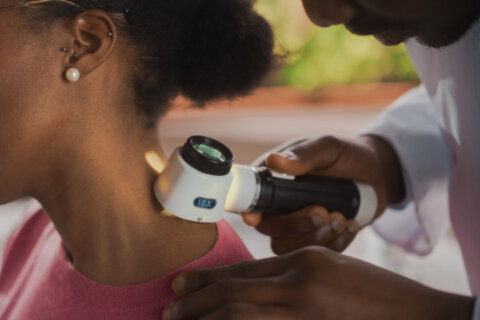Young athletes in the D.C. area at all levels are returning to practice fields this August, as fall sports preparation ramps up.
And while that return can be a ton of fun, doctors say student-athletes also need to be aware of their health to prevent injuries in the early part of the season.
“Especially with coaches ramping things up to get people in shape, injuries can happen,” said Jennifer Gourdin, a sports medicine physician with Kaiser Permanente in Silver Spring, Maryland.
Gourdin said the first three months of this sports season are a time when she typically sees the most patients, as student-athletes going “zero to a hundred very quickly” can get injured easily.
“The most common injuries I would say — are overuse-type injuries,” Gourdin said.
Among those overuse injuries: ACL tears.
“Especially in young female athletes, ACL tears are more common,” Gourdin said.
Gourdin said ACL tears are also slightly more common nowadays because children are encouraged to specialize and excel in one or two select areas from younger ages.
“It’s a phenomenon we call ‘early sports specialization,'” she explained. “If they play one specific sport for eight months or more out of the year, and don’t play any others during that time, those overuse injuries like ACL tears can happen.”
If you’re young, it might not be totally debilitating, but Gourdin notes it’s still serious.
“Young athletes will present with a feeling of their knee being unstable, or they may say they heard a pop,” she said.
Gourdin said the best way to prevent this from a coaching standpoint is to ease into things more slowly.
For athletes, she said, a variety of things, including stretching, dynamic warm-ups and watching your form are very important.
“Treatment for ACL tears can be surgical or nonsurgical,” said Gourdin. “The decision we make with athletes really depends on their age, their activity level and the demands of their sports.”
Coaches should also emphasize neuromuscular training, or teach athletes how to alter jumping and running forms to reduce risk of a tear.
Finally, strength training can also be a form of physical therapy or a preventive measure.
“If your quad muscles are stronger than your hamstrings, for example, that could place you at higher risk of injury,” Gourdin said.
Beyond the body, Gourdin also said the minds of young athletes can be vulnerable to injury.
Concussions can not only keep athletes off the field but out of the classroom as well.
Gourdin said athletics — particularly contact sports such as football — are responsible for nearly a quarter of concussions among kids in the U.S.
“Younger children are often at risk of more severe symptoms and a longer recovery period, too,” she added.
Any sign of wobbliness, disorientation, forgetfulness, mood swings, nausea and vomiting after a hit on the head should be taken seriously. Other symptoms can include lethargy, extreme tiredness and light sensitivity.
“Symptoms and signs vary from athlete to athlete,” Gourdin said.
She also said symptoms can be delayed, which is why it’s important for physicians and trainers to follow up with athletes 24 to 48 hours after a head injury. It’s also on the student-athletes to check in with trainers, and for coaches to be responsible and insist they get a proper evaluation.
Wearing appropriate-fitting gear such as helmets is incredibly important. But even then, head injuries can still occur.
“Helmets don’t necessarily prevent concussions, even if they do help,” she said. “There’s no concussion-proof helmet an athlete can wear.”
That’s why she said anyone on the sidelines who notices an athlete showing symptoms of a concussions should “remove that athlete from the game immediately. And make sure they’re seen by a physician.”








